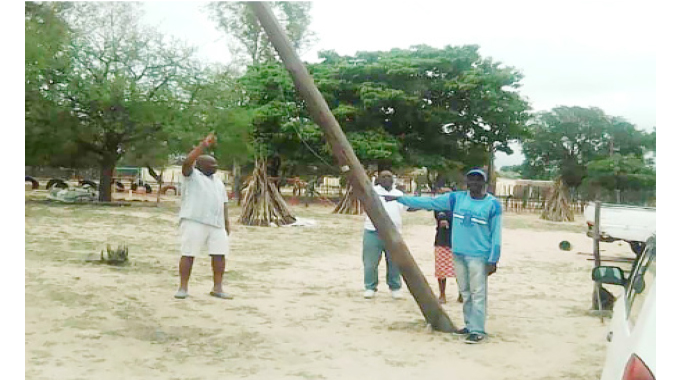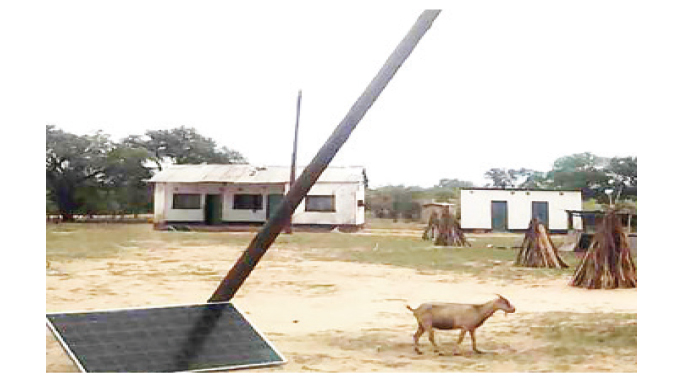Rural schools fight water, electricity scarcity

Kamangeni Phiri
Mr Leonard Dube, a headmaster, would like his remote Simbumbumbu Primary School in Gwanda to be connected to the national electricity grid, but termites keep frustrating his plans.
“If we are to expose our pupils to Information Communication Technology (ICT), we need electricity first then internet,” he says. “But white ants keep attacking power line poles, making it difficult for us to be connected to the national grid.”
In fact, the whole village of Simbumbumbu is under siege from the termites. The tiny insects are quite aggressive; they are destroying trees and perimeter fence poles.
As a result, all key institutions in the village are not connected to the national electricity grid.
Even water, the most basic and essential resource, is in short supply in Simbumbumbu village, which is in ward seven under Chief Mathema in Gwanda.
The situation is so dire that villagers in certain sections have to share water sources with animals.
“Our area does not have underground water. We rely mostly on the nearby Simbumbumbu Clinic for the precious liquid,” says Mr Dube.

An electricity pole that was attacked by termites at Simbumbumbu Primary School
The clinic has piped water drawn from Matshena River using a solar-powered submersible pump.
This is in contrast with the school’s biggest water storage facility – an old brick and cement tank that loses more water through leakages than it retains. The tank was used to store harvested rain water.
“Parents and the school tried to fix it without success. In the meantime, we are using the 1000l tank donated to us by a local non-governmental organisation, Uluntu Community Foundation, to store our harvested rain water,” said Mr Dube.
Simbumbumbu Primary School is one of many rural schools in semi-arid Gwanda district battling the intertwined challenges of accessing safe water and reliable electricity. Residents rely on boreholes and harvested water during rainy seasons. But in summer, boreholes quickly dry up, forcing villagers to depend on the limited water supplies.
Grid electricity is scarce and most institutions depend on a few solar packs that hardly meet their daily power needs.
Many agree the challenges are stifling rural development.
“At times teachers ask us (parents) to bring water to school for washing hands. We appreciate the importance of such a request, but it is difficult to always comply because we can get really busy with other duties at our homes,” said Mrs Witness Ngulube, a parent in Magedleni area.
It is mostly women and children who bear the brunt of water and electricity challenges in rural areas, said Mrs Zama Sibanda, wife to Simbumbumbu village head.
United Nations Sustainable Development Goals, five, six and seven are dedicated to Gender Equality, Clean Water and Sanitation and Affordable and Clean Energy respectively.
“As women, we participate more in the fetching of water and firewood for our homes. We lose a lot of production time walking long distances,” said Mrs Sibanda.
Lack of electricity at Simbumbumbu Business Centre has denied the village any prospects of having a vibrant home industry. Most of the village’s youths are lost to cities and neighbouring countries where they go in search of employment.
The business centre, composed of six or seven general dealer’s shops, only attracts a few of the village youths through the loud, fast-paced local music blasted from speakers of solar-powered hi-fis all day.
“There is not much to inspire our kids at the business centre. If we had electricity, we would be having home industries that create employment. With reliable water and electricity, we can boost enterprise and increase agricultural production,” said Mrs Sibanda.
Gwanda rural district’s villages have almost similar hydrological conditions. Broken hilly rocks are a common feature in the district which has low, erratic rainfall patterns and droughts induced by climate change.
Mr Dube, who first came to Simbumbumbu Primary School in 2009, is hopeful of ending the school’s woes in accessing safe water and reliable electricity before his time is up.
“Our quest for further growth is hinged on water and electricity availability. We are confident we will overcome the challenges. That is why we are constructing a computer lab. We even completed tubing our buildings way back in 2012,” he said.
The school is working on a lasting solution to its water woes by engaging the clinic over plans to extend piped water to the educational institution.
But about 90km away, another primary school, Magedleni School under Chief Masuku, keeps banking on the heavens for water. Previous efforts to search for the precious liquid underground have yielded dry holes.
“A District Development Fund (DDF) team was here last month (November), but failed to produce any water. The nearest water source is an unreliable borehole that is about two kilometres away. It dries up fast and at best, it yields two or three buckets only,” said the school head, Ms Utility Sibanda.
She said the community’s water woes were now affecting teachers and pupils’ work.
The teachers walk a distance of about three kilometres to a borehole at the shops whenever the nearest borehole dries up.
Pupils are at times sent to fetch water meant for the cleaning of the school and washing of hands. Hand washing is one of the WHO requirements meant to curb the spread of Covid-19.
Magedleni Primary was established in 1922 when water was not a challenge. Their nearest reliable water source is Silikwe River, about five km away.
“There was once talk to draw water from the river, but it has since gone quiet,” said Ms Sibanda.
The school has constructed a brick and cement tank at the teachers’ cottages to help ease water woes.
It is, however, a stop-gap measure as the tank will rely on harvested water which is seasonal.

Magedleni Primary School headmistress Ms Utility Sibanda
A pallid ray of hope for the beleaguered Magedleni School in its quest to develop is that it already has a computer lab and the school is connected to the national electricity grid, unlike its counterpart in Simbumbumbu.
But then, the achievement appears void in the absence of electricity, which the school last accessed in 2017.
“Electricity was briefly restored in June last year for a few weeks only. From July to date, we are still to access power. We are using a solar power pack bought by parents, but it is not enough to sustain our power needs. We have 48 laptops meant to be used by our pupils in their computer studies.
The kids’ performance can greatly improve, if we fully utilise the technology,” said the school head.
Magedleni Primary has an enrolment of 355 children and a staff complement of 10 teachers.
Rural Electrification Agency spokesperson, Mr Johannes Nyamayedenga said they were aware of the challenge in Gwanda’s Simbumbumbu village.
“Both the school and clinic in Simbumbumbu are not forgotten as well as the local chief’s homestead. We are working on rehabilitating the line,” he said.
A Zimbabwe Electricity Transmission and Distribution Company official said the rehabilitation of the Simbumbumbu line was projected to start within the first quarter of this year.
Government has connected over 90 000 rural institutions, including business centres, schools and chiefs’ homesteads, to the national grid since the launch of the National Renewable Energy Policy in 2017.
The Second Republic has set its sights on achieving goals of making sure that all rural schools and businesses are electrified by the year 2030, giving hope to schools like Simbumbumbu and Magedleni.
Energy and Power Development Minister, Soda Zhemu, said electricity at rural health institutions helps reduce the mortality rate.
“It also has the potential to improve the quality of lives in rural areas and enables the use of mass media tools such as the internet in schools,” he said 14 months ago while commissioning the Donsa Rural Electrification Programme in Silobela, Midlands.
The district’s water prospects are, however, not so bright.
Matabeleland South’s DDF Provincial Chief Water Technician, Mr Joseph Dube, said there was no immediate solution to the challenge in Chief Mathema and Chief Masuku’s areas.
“We are yet to find long term solutions to such deficiencies. The problem is there is a lack of underground water in those areas. No matter how and where, and how many metres you drill you can’t get any good yielding borehole. The geology is constrained of underground water recharge,” he said.
Mr Joseph Dube said Matshena River, which was sustaining Simbumbumbu Clinic, did not have plenty water to sustain additional demand while there was not enough sand in Silikwe River to sustain a mechanised pumping system.
“We cannot, therefore, connect additional pumping from the already constrained Matshena riversand aquifer. We also do not have an alternative water source for Magedleni.
We just believe that if we can get a good yielding borehole some kilometres away, we may do capacity tests. We will then put a pump and pipe the water from where ever the borehole will be to the consumers. This, however, will be expensive,” he said.









Comments